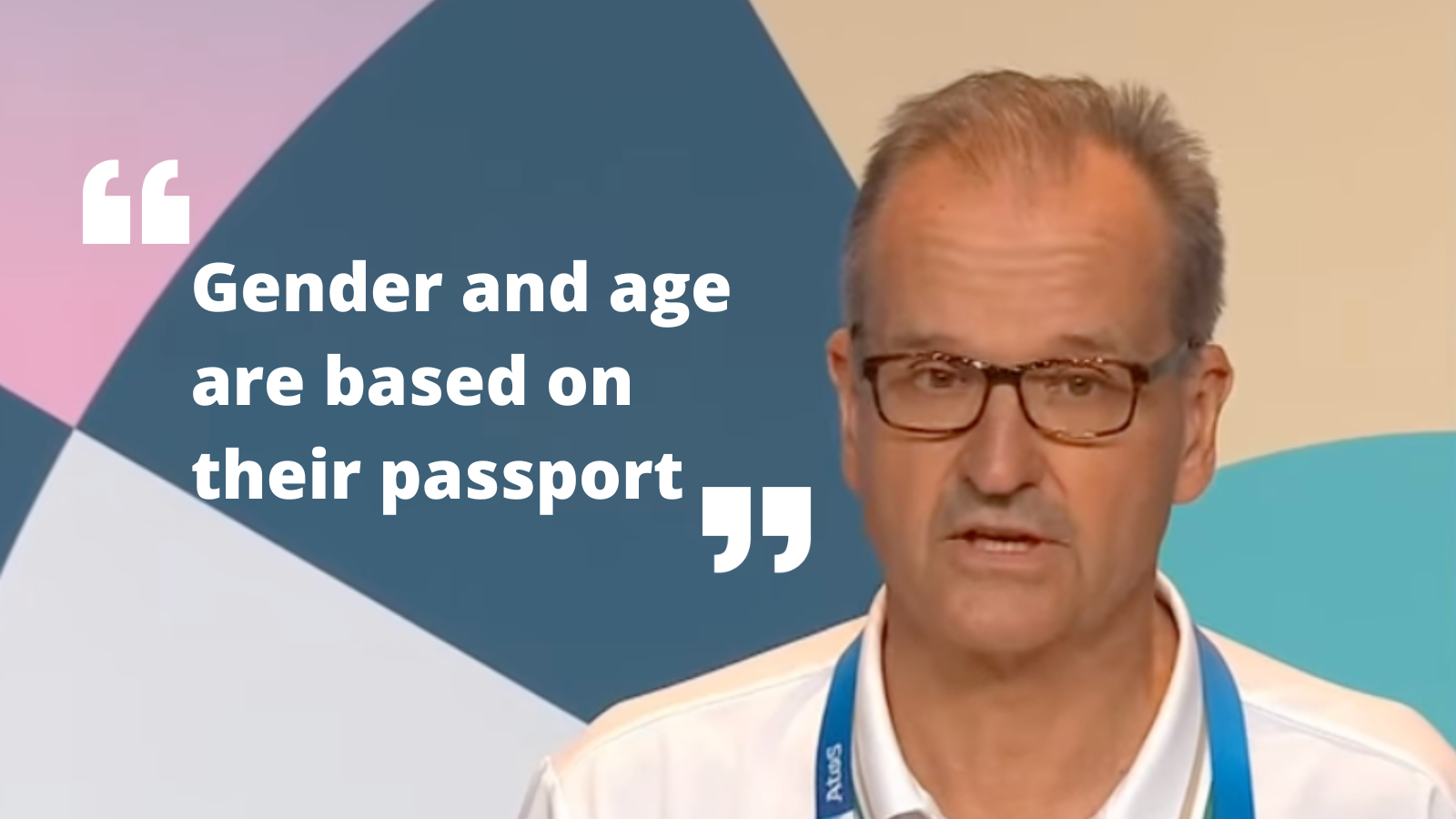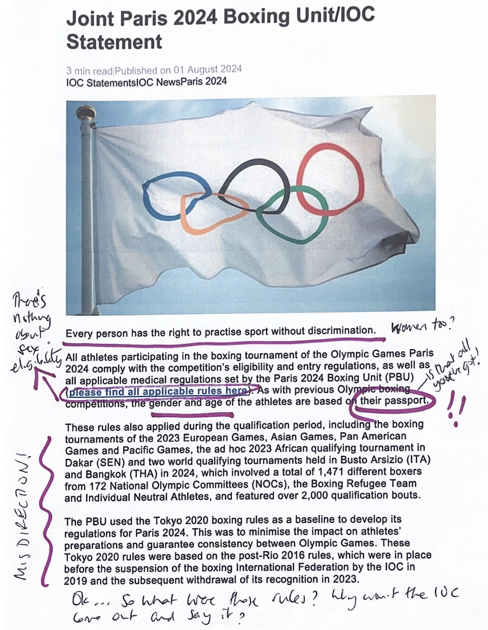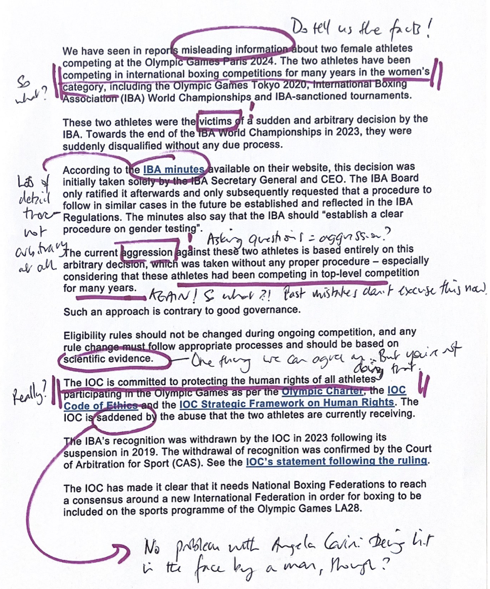The IOC doubles down on unfairness for women in boxing

The International Olympic Committee’s media briefing on 2nd August was dominated by questions about the eligibility of boxers in the women’s competition. Algerian Imane Khelif had won an opening bout in 46 seconds, amid concerns that the boxer is male. IOC spokesman Mark Adams was asked how the IOC planned to “stop this wave of negative press regarding both these two boxers and also the potentially unfair competition that affects the other boxers”. His answers showed a complete disregard for the second part of that question, implying that neither safety nor fairness can come before male inclusion.
He started by reading out the IOC statement from 1st August.


“Every person has the right to practise sport without discrimination.”
This is why a protected category for women and girls is necessary in almost every sport. Category rules exclude those who don’t belong in that category. Failing to protect the female category is discrimination against females. Exclusion of males is necessary for the inclusion of females.
“All athletes [in this event] comply with eligibility rules and entry regulations and applicable medical regulations.”
That is not a satisfactory answer if the rules are unfair. New Zealand male weightlifter Laurel Hubbard was allowed into the women’s competition in the Tokyo Olympics but would not be now, since the International Weightlifting Federation changed its rules.
“Gender and age are based on their passport.”
Sex is material reality. It is not changed by what’s written on a piece of paper. If this is the extent of the requirements, it gives no confidence that competitors will face a fair fight.
“The PBU used the Tokyo 2020 boxing rules.”
But that was also run by the IOC.
“They were based on the post-Rio rules in 2016.”
At that time the IOC policy was testosterone suppression. A journalist later asked Mark Adams to spell out what those post-Rio rules were, but he did not answer the question. He claimed it was in the 10-page attachment linked to the statement. But there is nothing in those attachments relating to eligibility for men’s and women’s, or male and female, competition. In a long list of technical details about gloves, scales, uniforms, it says neither men nor women can have long hair that is not tied back, and women may not be pregnant. There are no definitions of man or woman.
“The two athletes have been competing in women’s boxing competitions for many years.”
Since 2018, it seems. But past mistakes do not justify current injustices.
“These two athletes were the victims of a sudden and arbitrary decision…”
Minutes of a board meeting of the International Boxing Association (IBA) show that tests were sent to a laboratory. Any decision may appear sudden, but that doesn’t make it wrong or arbitrary. The IOC no longer recognises the IBA, so it is not surprising to see it dismiss IBA decisions.
“The current aggression against these two athletes…”
The anger is mostly against the IOC for putting women in this situation. Is it aggressive to ask why boxers previously deemed ineligible are now allowed? If the IOC cannot come up with a better reason than “their passports say they are female”, it can expect this debate to continue.
“Rules should be based on scientific evidence…”
At last something on which we can agree. But the IOC’s 2021 framework document says there should be “no presumed advantage” for transgender or DSD athletes (those with disorders of sexual development). This is tantamount to saying there should be no presumed advantage for male athletes over female ones.
“The IOC is committed to protecting the human rights of all athletes participating in the Olympic Games…”
But not the women, it seems.
More doublespeak in the media conference
After reading the statement Adams answered questions. Asked about the science, he said:
“There is no scientific consensus. We at the IOC would be interested to hear of such a consensus.”
There is widespread consensus that the IOC is getting this badly wrong. It has funded a study which other academics have debunked as poor science with misleading conclusions. Many other studies point to male exclusion as the only way to guarantee fair and safe competition for females.
Adams was asked about sex testing, and repeated his comments from the previous day:
“I don’t think anyone wants to see a return to that… This is a minefield… if we can find a consensus, and we will work towards a consensus, we will certainly work to apply that… this is a question in all sports…we are open to listen to anyone with a solution to that question.”
It really isn’t a minefield. Sex testing is done with a simple cheek swab. Most female athletes wanted it and still do. If that is what the IOC believes, they need to ask women, and listen to the answer. They might also ask World Athletics, World Aquatics or UCI (cycling) how they are managing to operate their Female and Open categories.
“There are, or can be, suspicions about people’s sex. It is not up to us to act on all those suspicions.”
This is the IOC saying it will not enforce regulations in the boxing competition, even though it has taken over from the IBA. Would the same apply if there were rumours of doping? Adams answered a question about testing of the Chinese swimming team without expressing any doubts about the IOC’s responsibility to ensure clean sport.
“The Algerian boxer was registered as female… this is not a transgender issue or a man fighting a woman.”
How someone is registered is not proof of their sex. People may be incorrectly registered at birth, or their documents may later be changed. In the UK, the sex marker on a passport can be changed with a doctor’s letter.
Asked whether to favour inclusion or safety of athletes, Adams replied:
“The IOC is always trying to balance inclusivity and fairness, to put it more broadly, also safety. That is a difficult one and something we will have to look at. That’s an entirely separate question to what’s going on here, which is a women boxer being stigmatised and potentially forced out of the competition.”
Safety can never be balanced with inclusion. Aiming for inclusion is laudable but that should never be at the expense of other people’s safety.
“There are many women with higher levels of testosterone than men.”
This is false. There is no overlap between the testosterone levels of healthy women (0.2 to 1.4 nanomoles per litre) and healthy men (10 to 30 nanomoles per litre).
What will it take?
Many sports have been unfair to women for years, but rarely do we see such reckless disregard for safety, defended as “inclusion”. Our video asks: What will it take for this dangerous situation to be addressed?
Sex Matters is calling on the Secretary of State to recognise that leaving this to individual sports governing bodies is not working. It’s time for firm action from the government.
Read our briefings on:
And see also:
